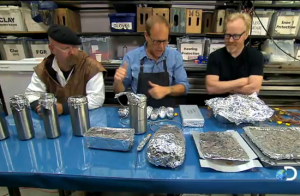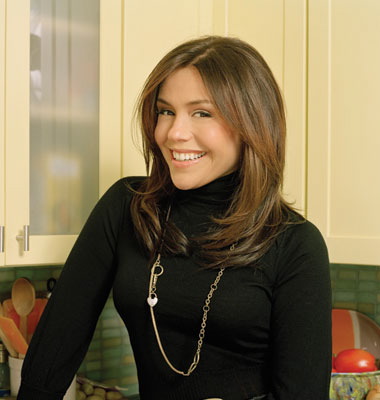Rachael Ray (right, sampling goods in Florida last weekend) offered up some suggestions for so-called healthier cooking in that annoying USA Weekend insert to many local newspapers, including this gem:
"Look at labels. … If you can’t read an ingredient, chances are you should not be putting it in your body."
 Dr. Dean Cliver, who officially retired October 1, 2007 and is winding down from 46 years in academia, battling infectious agents in food and water, realized that he had come up to the solution to this very problem some 20 years ago and decided to once again share his thoughts with barfblog.com. Dr. Cliver’s proposed label is left, bottom.
Dr. Dean Cliver, who officially retired October 1, 2007 and is winding down from 46 years in academia, battling infectious agents in food and water, realized that he had come up to the solution to this very problem some 20 years ago and decided to once again share his thoughts with barfblog.com. Dr. Cliver’s proposed label is left, bottom.
The following was originally published in University of Wisconsin-Madison AG LIFE LINES, College of Agricultural and Life Sciences, Vol. 4, No. 2, page 6, and republished in the Journal of Irreproducible Results, Vol. 34, No. 4, Mar-Apr 1989, page 18.
A subtle and probably pernicious trend in the U.S. food supply seems to be occurring virtually unnoticed. If one reads the information on a food package, as it seems few do, one finds that many food in the U.S. today are composed almost entirely of ingredients. The use of ingredients in foods has become so widespread and flagrant that one can hardly guess what will appear next on the growing list of polysyllabic horrors printed on packages. Through insouciance or ineptitude, we have let the situation get quite out of hand.
Labels seem to be intended rather to obfuscate than to inform. Aside from water, which evidently abounds in these products (though who knows where it has been before it goes into the food?), hardly any of the names that appear on these lists are comprehensible to the average consumer or even pronounceable. The acronyms are even worse. It is not enough to know that “BHA” stands for “butylated hydroxyanisol.” How are we to know where and by whom the hydroxyanisole we are about to ingest was butylated or whether the hydroxyanisole itself was natural or synthetic?
Though most consumers apparently do not read labels at all, those who do seem to have become jaded. My son asked me recently whether the “regular”-flavored generic toothpaste we had just purchased contained natural or artificial regular. And what about the blind — should lists also appear in Braille?
 There is little doubt that most of these ingredients are harmful, at least at some level, in foods. Why, for example, would salt be listed as “sodium chloride” if there were nothing to hide? Would any of us willingly be called “The Sodium Chloride of the Earth"? Sugar now comes in enough forms to confound the ablest pancreas. Fats are listed as though they were all polyunsaturated, without any indication of the degree of polity. Plain, American English is nowhere to be found.
There is little doubt that most of these ingredients are harmful, at least at some level, in foods. Why, for example, would salt be listed as “sodium chloride” if there were nothing to hide? Would any of us willingly be called “The Sodium Chloride of the Earth"? Sugar now comes in enough forms to confound the ablest pancreas. Fats are listed as though they were all polyunsaturated, without any indication of the degree of polity. Plain, American English is nowhere to be found.
Not only are we consuming ingredients ourselves, but we are inflicting them on our unsuspecting children, mindless of potential harm to all future generations. Small wonder that behavioral problems abound in the society whose children have been fed ingredients virtually from birth! For example, many young people today are probably essentially addicted to calcium propionate in their bread. What becomes of them if their supply is cut off? Packages marked “no preservatives” should probably be viewed with extreme caution.
Time and the press have made it clear that the predominance of ingredients in U.S. foods is largely due to the greed of profit-hungry food manufacturers. There is little doubt that this is true: if one travels to parts of the world where the profit motive has been outlawed, one finds that foods are virtually free of ingredients. This has such a favorable effect on quality that people are willing to stand in long lines for food every day. By contrast, hardly anyone stands in line to get food in the U.S. — with all those ingredients why bother?
I submit that the time has come for action on this matter. Consumer groups and enlightened members of the general public must bring pressure to bear on Congress and the U.S. Food and Drug Administration to mandate reduced levels of ingredients in foods, probably with a view to an eventual complete ban. Nowadays, virtually the only food one can buy that is almost certainly free of ingredients is an egg in its original shell, and we are now being told not to eat more than one of them per week. How are we to survive on such a diet?
American food manufacturers, in their cupidity, must not be allowed to continue perpetrating this sesquipedalian atrocity on the indifferent or benighted public. Let us speak out now, so that those in government will recognize their duty to regulate, reduce, and eventually eliminate ingredients from the US food supply! Let’s get the American public back on real, ingredient-free food, before accumulated subtle deficiencies and abnormalities put us all under the table to stay. Our posterity and their posterity demand this of us.
 turkey.
turkey.
.jpg) (watching the Stanley Cup final live at 10 a.m. yesterday made for excellent background viewing).
(watching the Stanley Cup final live at 10 a.m. yesterday made for excellent background viewing).

 Dr. Dean Cliver, who officially retired October 1, 2007 and is winding down from 46 years in academia, battling infectious agents in food and water, realized that he had come up to the solution to this very problem some 20 years ago and decided to
Dr. Dean Cliver, who officially retired October 1, 2007 and is winding down from 46 years in academia, battling infectious agents in food and water, realized that he had come up to the solution to this very problem some 20 years ago and decided to  There is little doubt that most of these ingredients are harmful, at least at some level, in foods. Why, for example, would salt be listed as “sodium chloride” if there were nothing to hide? Would any of us willingly be called “The Sodium Chloride of the Earth"? Sugar now comes in enough forms to confound the ablest pancreas. Fats are listed as though they were all polyunsaturated, without any indication of the degree of polity. Plain, American English is nowhere to be found.
There is little doubt that most of these ingredients are harmful, at least at some level, in foods. Why, for example, would salt be listed as “sodium chloride” if there were nothing to hide? Would any of us willingly be called “The Sodium Chloride of the Earth"? Sugar now comes in enough forms to confound the ablest pancreas. Fats are listed as though they were all polyunsaturated, without any indication of the degree of polity. Plain, American English is nowhere to be found. "I’m speaking, of course, about Ms. (Rachel) Ray’s complete refusal to adhere to national guidelines regarding the consumption of raw eggs and seafood. To be fair, Emeril "Beer Belly" Lagasse, as well as Mario "Anyeurism" Batali also ignore these warnings, and regularly use raw eggs in many of their concoctions. But these two individuals, obese and stinky as they may be, can actually cook, whereas Rachael Ray cannot."
"I’m speaking, of course, about Ms. (Rachel) Ray’s complete refusal to adhere to national guidelines regarding the consumption of raw eggs and seafood. To be fair, Emeril "Beer Belly" Lagasse, as well as Mario "Anyeurism" Batali also ignore these warnings, and regularly use raw eggs in many of their concoctions. But these two individuals, obese and stinky as they may be, can actually cook, whereas Rachael Ray cannot."